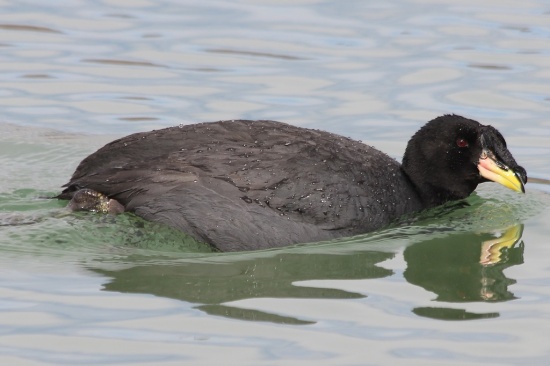(Clearer image added. References updated) |
(Attempt to disguise copied text. Some extra info. References updated) |
||
| Line 3: | Line 3: | ||
==Identification== | ==Identification== | ||
| − | + | 46–53 cm (18-20¾ in); a very large coot | |
| + | *Slate-grey head and body | ||
| + | *Paler underparts | ||
| + | *Black undertail-[[Topography#General Anatomy|coverts]] with two white stripes | ||
| + | *Olive-yellow bill changing to orange at the base | ||
| + | :*Three black [[Dictionary_T-Z#W|wattles]] form the frontal shield, the central one is longer and covers the upper mandible | ||
==Distribution== | ==Distribution== | ||
| − | + | [[South America]]: South-western [[Bolivia]] to northern [[Chile]] and northwestern [[Argentina]]. | |
==Taxonomy== | ==Taxonomy== | ||
This is a [[Dictionary_M-S#M|monotypic]] species<sup>[[#References|[1]]]</sup>. | This is a [[Dictionary_M-S#M|monotypic]] species<sup>[[#References|[1]]]</sup>. | ||
| Line 11: | Line 16: | ||
Lakes and lagoons in the high Andes. | Lakes and lagoons in the high Andes. | ||
==Behaviour== | ==Behaviour== | ||
| − | They build a platform of stones and vegetation for | + | ====Diet==== |
| + | There is not much detail. It is, however, known that they eat aquatic plants and grass. | ||
| + | ====Breeding==== | ||
| + | [[Dictionary_M-O#M|Monogamous]] and can breed in colonies of up to 80 pairs. They build a platform of stones and vegetation for the nest. | ||
==References== | ==References== | ||
#{{Ref-Clements6thAug17}}#Alvaro Jaramillo. 2003. Birds of Chile. Princeton Field Guides. ISBN 0-691-11740-3 | #{{Ref-Clements6thAug17}}#Alvaro Jaramillo. 2003. Birds of Chile. Princeton Field Guides. ISBN 0-691-11740-3 | ||
| + | #The Beauty of Birds | ||
{{ref}} | {{ref}} | ||
==External Links== | ==External Links== | ||
{{GSearch|Fulica+cornuta}} | {{GSearch|Fulica+cornuta}} | ||
[[Category:Birds]][[Category:Fulica]] | [[Category:Birds]][[Category:Fulica]] | ||
Revision as of 19:51, 19 February 2018
- Fulica cornuta
Identification
46–53 cm (18-20¾ in); a very large coot
- Slate-grey head and body
- Paler underparts
- Black undertail-coverts with two white stripes
- Olive-yellow bill changing to orange at the base
- Three black wattles form the frontal shield, the central one is longer and covers the upper mandible
Distribution
South America: South-western Bolivia to northern Chile and northwestern Argentina.
Taxonomy
This is a monotypic species[1].
Habitat
Lakes and lagoons in the high Andes.
Behaviour
Diet
There is not much detail. It is, however, known that they eat aquatic plants and grass.
Breeding
Monogamous and can breed in colonies of up to 80 pairs. They build a platform of stones and vegetation for the nest.
References
- Clements, J. F., T. S. Schulenberg, M. J. Iliff, D. Roberson, T. A. Fredericks, B. L. Sullivan, and C. L. Wood. 2017. The eBird/Clements checklist of birds of the world: v2017, with updates to August 2017. Downloaded from http://www.birds.cornell.edu/clementschecklist/download/
- Alvaro Jaramillo. 2003. Birds of Chile. Princeton Field Guides. ISBN 0-691-11740-3
- The Beauty of Birds
Recommended Citation
- BirdForum Opus contributors. (2024) Horned Coot. In: BirdForum, the forum for wild birds and birding. Retrieved 29 April 2024 from https://www.birdforum.net/opus/Horned_Coot




